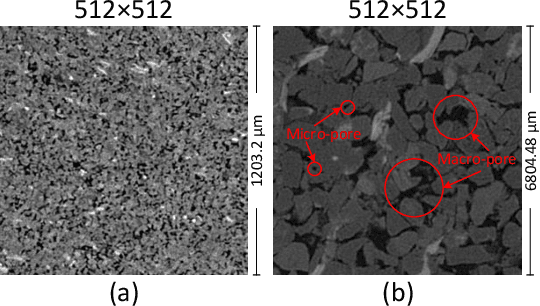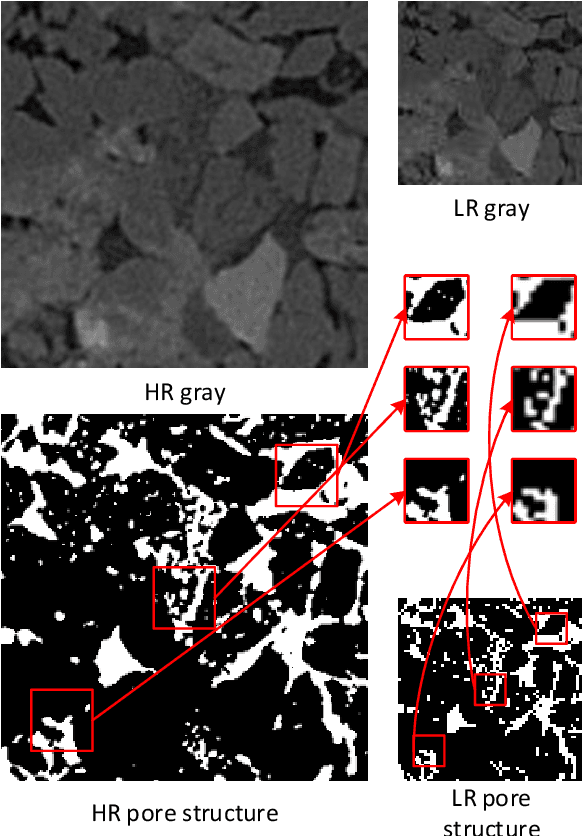Zhenchuan Ma
Statistically controllable microstructure reconstruction framework for heterogeneous materials using sliced-Wasserstein metric and neural networks
Nov 18, 2025Abstract:Heterogeneous porous materials play a crucial role in various engineering systems. Microstructure characterization and reconstruction provide effective means for modeling these materials, which are critical for conducting physical property simulations, structure-property linkage studies, and enhancing their performance across different applications. To achieve superior controllability and applicability with small sample sizes, we propose a statistically controllable microstructure reconstruction framework that integrates neural networks with sliced-Wasserstein metric. Specifically, our approach leverages local pattern distribution for microstructure characterization and employs a controlled sampling strategy to generate target distributions that satisfy given conditional parameters. A neural network-based model establishes the mapping from the input distribution to the target local pattern distribution, enabling microstructure reconstruction. Combinations of sliced-Wasserstein metric and gradient optimization techniques minimize the distance between these distributions, leading to a stable and reliable model. Our method can perform stochastic and controllable reconstruction tasks even with small sample sizes. Additionally, it can generate large-size (e.g. 512 and 1024) 3D microstructures using a chunking strategy. By introducing spatial location masks, our method excels at generating spatially heterogeneous and complex microstructures. We conducted experiments on stochastic reconstruction, controllable reconstruction, heterogeneous reconstruction, and large-size microstructure reconstruction across various materials. Comparative analysis through visualization, statistical measures, and physical property simulations demonstrates the effectiveness, providing new insights and possibilities for research on structure-property linkage and material inverse design.
A fast and flexible algorithm for microstructure reconstruction combining simulated annealing and deep learning
Apr 25, 2023



Abstract:The microstructure analyses of porous media have considerable research value for the study of macroscopic properties. As the premise of conducting these analyses, the accurate reconstruction of microstructure digital model is also an important component of the research. Computational reconstruction algorithms of microstructure have attracted much attention due to their low cost and excellent performance. However, it is still a challenge for computational reconstruction algorithms to achieve faster and more efficient reconstruction. The bottleneck lies in computational reconstruction algorithms, they are either too slow (traditional reconstruction algorithms) or not flexible to the training process (deep learning reconstruction algorithms). To address these limitations, we proposed a fast and flexible computational reconstruction algorithm, neural networks based on improved simulated annealing framework (ISAF-NN). The proposed algorithm is flexible and can complete training and reconstruction in a short time with only one two-dimensional image. By adjusting the size of input, it can also achieve reconstruction of arbitrary size. Finally, the proposed algorithm is experimentally performed on a variety of isotropic and anisotropic materials to verify the effectiveness and generalization.
Multiscale reconstruction of porous media based on multiple dictionaries learning
May 16, 2022



Abstract:Digital modeling of the microstructure is important for studying the physical and transport properties of porous media. Multiscale modeling for porous media can accurately characterize macro-pores and micro-pores in a large-FoV (field of view) high-resolution three-dimensional pore structure model. This paper proposes a multiscale reconstruction algorithm based on multiple dictionaries learning, in which edge patterns and micro-pore patterns from homology high-resolution pore structure are introduced into low-resolution pore structure to build a fine multiscale pore structure model. The qualitative and quantitative comparisons of the experimental results show that the results of multiscale reconstruction are similar to the real high-resolution pore structure in terms of complex pore geometry and pore surface morphology. The geometric, topological and permeability properties of multiscale reconstruction results are almost identical to those of the real high-resolution pore structures. The experiments also demonstrate the proposal algorithm is capable of multiscale reconstruction without regard to the size of the input. This work provides an effective method for fine multiscale modeling of porous media.
 Add to Chrome
Add to Chrome Add to Firefox
Add to Firefox Add to Edge
Add to Edge